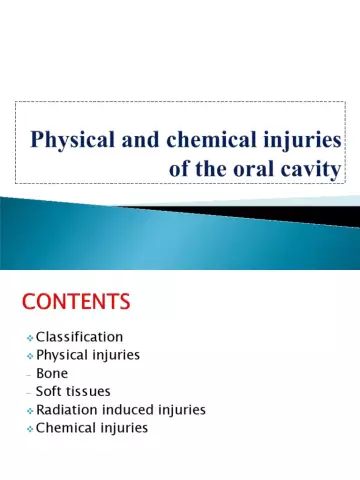- Author Rachel Wainwright [email protected].
- Public 2023-12-15 07:39.
- Last modified 2025-11-02 20:14.
Oral hygiene - a necessity or a conspiracy of marketers?
Each of us has heard stories about people who never brushed their teeth and did not have any problems. So, most likely, these people either did not know about their diseases, because they did not visit dentists, or they lied (for some reason, no one is considering this option). Oral health is only partially dependent on genetic predisposition, but to a greater extent on the level of hygiene. And now we will figure out exactly how oral care or lack thereof affects health.
Where do tooth decay and other oral diseases come from?
Within a few hours after brushing, plaque begins to form on the teeth - a thin film of bacteria, food debris, dead cells of the oral mucosa. If you do not clean it regularly, plaque will accumulate, harden, turning into tartar. Plaque bacteria cause gum inflammation, erode tooth enamel, and cause tooth decay. In the absence of timely treatment, these problems are transformed into more serious diseases, such as periodontitis or pulpitis.

All this can be avoided only with regular and high-quality hygiene. You need to brush your teeth at least twice a day, and in some clinical situations - more often, after each meal. Choose a brush responsibly - it should not be too soft or hard for you. Proper brushing technique must be followed. And most importantly, in addition to the toothbrush, brushing should be done with an oral irrigator.
What is an irrigator and how does it work?
The Waterpik oral irrigator is a device that was invented back in 1958 by American scientists - dentist and engineer. Its principle of operation is based on the action of a jet of water supplied under pressure - it cleans the interdental spaces, gingival pockets and other hard-to-reach areas of the oral cavity, massages the gums and improves blood circulation in them.

Many have heard about the Waterpik irrigator from their dentist, since this device is simply indispensable for some patient groups:
- when wearing braces, it helps to clean them and prevent tooth decay.
- In the presence of crowns and implants, the irrigator helps to remove plaque from artificial teeth, as well as to clean out gingival pockets, thereby ensuring the longest service life of the structures.
- The Waterpik irrigator is recommended for patients with problematic gums, including pregnant women and people with diabetes.
- For smokers, the Waterpik irrigator helps to get rid of bad breath, as well as minimize the harm from the effects of tobacco on the oral cavity.
However, it is important to understand that the Waterpik irrigator is needed not only for those who already have any problems, but also for healthy people to prevent these problems. Even with regular brushing twice a day, a toothbrush is not able to provide an adequate level of hygiene: it is not able to penetrate into the interdental spaces and other hard-to-reach areas of the oral cavity. Only the Waterpik irrigator can handle this challenge, protecting you from plaque, tooth decay, bad breath and other more serious conditions.
Which irrigator should you choose?
Waterpik irrigators are divided into two main groups: portable and stationary. Portable ones are smaller, compact, convenient to take with you everywhere, run on battery power, and require recharging every 5-7 days. Stationary ones work from an outlet, they are most convenient for family use, they have more modes of pressure levels.

Each Waterpik irrigator is equipped with different types of attachments: standard - for general use, attachments for braces, for crowns, implants, for gum pocket care, brush attachments, attachments for cleaning the tongue. All attachments can be purchased separately so that each user has his own individual.
Choose the Waterpik irrigator that suits you and place an order on the website of the official distributor of the brand in the Russian Federation.
Found a mistake in the text? Select it and press Ctrl + Enter.






